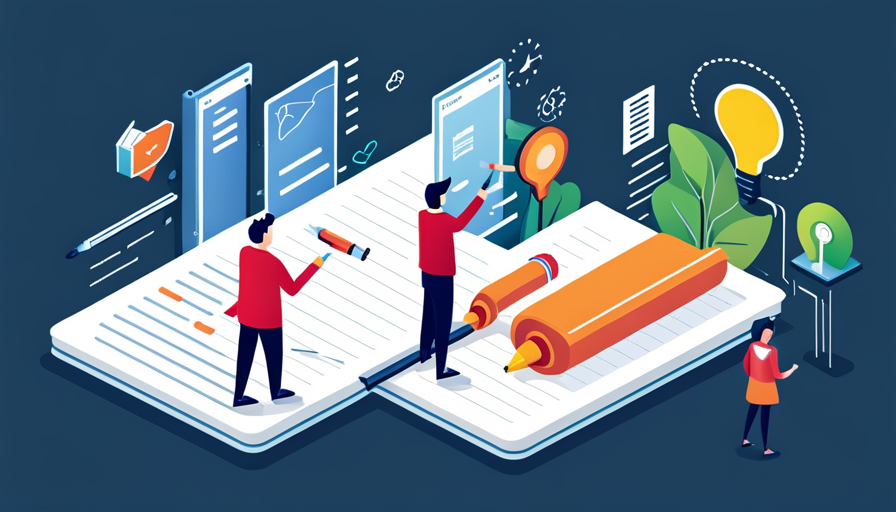Do you ever find yourself getting confused between note-taking and summarizing? While both strategies involve capturing information from a source, they serve different purposes and can be used in different situations. Understanding the distinction between note-taking and summarizing can help you choose the best strategy for your learning needs and goals.
Note-taking is the process of recording information from a source, such as a lecture or text, in a way that is organized and easy to review later. It involves capturing key ideas, concepts, and details, often using abbreviations, symbols, and diagrams. Note-taking can help you stay engaged and focused during a lecture, retain information, and review material more efficiently.
On the other hand, summarizing involves condensing information from a source into a shorter, more concise version. It involves identifying the main points and key ideas and leaving out less important details. Summarizing can help you understand complex information, identify the most important points, and communicate information to others more effectively.
In this article, we will explore the differences between note-taking and summarizing, and provide techniques for effective use of each strategy.
Key Takeaways
- Note-taking involves recording information in an organized way for later review while summarizing is condensing information into a shorter, more concise version.
- Effective note-taking requires active listening, organization of information, and the use of techniques such as paraphrasing and outlining.
- Choosing the best strategy for note-taking or summarizing involves experimenting with different techniques and considering personal learning preferences and goals.
- Both effective note-taking and summarizing improve comprehension, retention, and communication skills, and require critical thinking and active listening.
The Purpose and Benefits of Note Taking
You’ll love note-taking because it helps you stay focused and organized, making it easier to retain information and recall it later. When you take notes, you are actively engaging with the material and processing it in a way that makes sense to you. This helps you to understand the information better, and to remember it more effectively.
Note-taking can also help you to identify the main points of a lecture or presentation, and to organize your thoughts in a logical manner.
Of course, there are also drawbacks to note-taking. It can be time-consuming, and if you’re not careful, you may end up copying down too much information, which can be overwhelming.
However, with the rise of technology, note-taking has become easier and more efficient. You can use tools like apps and websites to take notes quickly and easily and to organize them in a way that makes sense to you.
Ultimately, note-taking is a valuable skill that can help you to learn more effectively and to achieve your academic and professional goals.
The Purpose and Benefits of Summarizing
When it comes to understanding complex information, summarizing is a valuable tool that can help you condense information, identify important ideas and details, and communicate complex ideas.
By summarizing, you can break down lengthy material into key points, making it easier to remember and understand. Additionally, summarizing can help you distinguish between essential and non-essential information, allowing you to focus on what’s most crucial.

Condensing Information
Condensing information can be tough, but it’s crucial for effective summarizing. To condense information, consider the following methods for condensing:
- Identify the main idea: Determine the central message of the text or lecture. This will help you focus on the most important information to include in your summary.
- Cut out unnecessary details: Eliminate redundant or irrelevant information that doesn’t contribute to the main idea.
- Use keywords: Use keywords and phrases to highlight important information and connect ideas.
- Paraphrase: Instead of copying word-for-word, try to rephrase the information in your own words to demonstrate your understanding.
Note-taking tips can also help with condensing information. When taking notes, try using abbreviations, symbols, and shorthand to quickly capture important information. Use headings and subheadings to organize your notes and make connections between ideas.
Additionally, try to summarize information in your notes as you go along, rather than waiting until the end of the lecture or text. By practicing these methods and tips, you can become more efficient at condensing information and ultimately improve your summarizing skills.
Remember, summarizing isn’t simply copying and pasting information. It requires a deeper level of understanding and analysis of the main idea. By condensing information using these methods and note-taking tips, you can create a more concise and effective summary that accurately represents the original text or lecture.
Identifying Important Ideas and Details
Imagine you’re a detective trying to solve a case, and the key to cracking it lies in identifying the important ideas and details hidden within the text or lecture. This is exactly what you need to do when it comes to note-taking and summarizing.
Identifying key points and details is crucial to effective note-taking strategies. You need to be able to recognize what’s important and relevant to the topic at hand and then write it down in a way that’s concise, clear, and organized. One effective way to identify key points is to pay attention to cues given by the speaker or writer.
Look for repetition, emphasis, and transitional phrases. These are all signs that the information being presented is important. Additionally, try to identify the main ideas and supporting details. Main ideas are the overarching themes or concepts while supporting details provide evidence or examples to support those ideas.
By identifying both, you can create a comprehensive summary that captures the essence of the text or lecture. Incorporating these strategies into your note-taking will not only improve your understanding of the material but also make it easier to review and remember the information later on.
Communicating Complex Ideas
Communicating complex ideas can be challenging, but with proper techniques, you can convey your message effectively and leave a lasting impact on your audience.
One of the most effective ways to communicate complex ideas is by using visual aids. Visual aids can help make your ideas more tangible and easier to understand. You can use charts, graphs, and diagrams to illustrate your points and make them more memorable. By using visual aids, you can help your audience follow your thought process and reduce the risk of misinterpretation.
Another way to communicate complex ideas is by simplifying your language. Using technical jargon and complex vocabulary can make your ideas harder to understand. Instead, use simple and straightforward language to convey your message. You can also break down complex ideas into smaller, more manageable pieces. By doing so, you can help your audience grasp your ideas more easily and follow your thought process.
Overall, by using visual aids and simplifying language, you can communicate complex ideas more effectively and leave a lasting impact on your audience.

Techniques for Effective Note Taking
When it comes to effective note-taking, there are several techniques that you can use to ensure that you’re capturing information accurately and efficiently.
The first step is to listen attentively, making sure that you’re fully focused on what’s being said.
Once you have the information, you can organize it in a way that makes sense to you. Use headings and bullet points to break it down.
Finally, using abbreviations and symbols can help you capture more information in less time, allowing you to keep up with the pace of the conversation.
Listening Attentively
By actively tuning in and absorbing information like a sponge, you can listen attentively and fully grasp the essence of the conversation. When it comes to note-taking, active listening is key. This means focusing your attention on the speaker, avoiding unnecessary distractions, and taking note of important points.
Here are a few tips to help you listen attentively:
- Be present: Avoid multitasking and give the speaker your full attention. This means putting away your phone, closing your laptop, and minimizing any other potential distractions.
- Ask questions: Clarify any points that you don’t understand by asking questions. This not only helps you understand the information better, but also shows the speaker that you’re engaged and interested in what they’re saying.
- Paraphrase: Repeat back what you’ve heard in your own words to ensure that you’ve understood the message correctly. This also helps you retain the information better.
- Take breaks: If you find yourself losing focus, take a short break to refocus your attention. This could mean taking a few deep breaths, stretching, or simply taking a quick walk around the room.
Incorporating these techniques into your note-taking process will help you listen attentively, retain information better, and ultimately produce more comprehensive and effective notes.

Organizing Information
To effectively organize information, it’s important to categorize and group related ideas together in a logical manner. This is where note-taking methods and outlining techniques come into play.
When taking notes, it’s easy to end up with a jumbled mess of information that’s difficult to make sense of later on. Outlining helps to avoid this by breaking down information into clear, concise sections that are easy to follow.
When outlining, start with the main topic or idea and then break it down into subtopics or supporting ideas. From there, you can further break down each subtopic into smaller details or examples. This creates a clear and organized structure that makes it easy to see how different pieces of information relate to each other.
By taking the time to organize your notes and thoughts, you’ll be able to better understand and retain the information you’re learning.
Using Abbreviations and Symbols
You can easily improve your notes by using abbreviations and symbols, even if you think you don’t have enough time to write everything out fully. Abbreviation techniques and symbol usage in note-taking can help you save time and energy while retaining important information.
Here are some ways to use abbreviations and symbols in your note-taking process:
- Use arrows to indicate cause and effect relationships between ideas.
- Use a plus sign (+) to show the addition of new information.
- Use an asterisk (*) to mark important points or key concepts.
- Use abbreviations for commonly used words, such as ‘w/’ for ‘with’ or ‘b/c’ for ‘because’.
- Use shorthand for frequently used words or phrases, such as ‘govt’ for ‘government’ or ‘I.e.’ for ‘that is’.
By using these abbreviation techniques and symbol usage in note-taking, you can streamline the note-taking process and retain more information. You’ll be able to write more quickly and efficiently, while also making sure you capture all the important details.
With practice, you’ll find that using abbreviations and symbols becomes second nature and you’ll wonder how you ever took notes without them.
Techniques for Effective Summarizing
Mastering effective summarizing techniques can enhance your understanding of the material by condensing important information into a concise format. This skill requires active listening, critical thinking, and selective reading.
To effectively summarize, you must first identify the main ideas and supporting details of the text. This involves paying attention to the author’s purpose, tone, and style, as well as any patterns or themes that emerge.
Once you have a clear understanding of the text, you can begin to condense the information into a summary. This requires concise writing, which involves selecting the most important information and leaving out any extraneous details.
A good summary should be clear, accurate, and complete. It should also be tailored to the needs of your audience, highlighting the most important information and providing context as needed.
By mastering effective summarizing techniques, you can improve your comprehension of the material and become a more efficient and effective communicator.

Choosing the Best Strategy for Your Learning Needs and Goals
If you’re unsure of which strategy aligns with your learning needs and goals, don’t worry. It’s normal to feel overwhelmed with the variety of techniques available.
The key is to experiment with different strategies to find what works best for you. Remember, learning preferences and personal goals vary from person to person. What may work for someone else may not necessarily work for you.
To determine which strategy to use, start by identifying your learning preferences. Do you prefer visual aids or verbal explanations? Do you learn best by doing or listening? Once you know your learning style, you can choose a technique that aligns with it.
Additionally, consider your personal goals. Are you trying to remember information for a test or simply trying to understand a concept? Your goals will dictate the level of detail you need to include in your notes or summary.
By taking the time to experiment with different techniques and considering your learning preferences and personal goals, you’ll be able to find the best strategy for you.
Conclusion
Now that you understand the distinction, you can choose the best strategy to fit your learning needs and goals.
Both note-taking and summarizing have their benefits and techniques for effectiveness, so it’s up to you to decide which strategy to use in various situations.
Remember, note-taking is great for capturing all the details, and summarizing is great for condensing information.
So, whether you’re studying for an exam or trying to remember a presentation, choose the strategy that fits your needs and goals.
